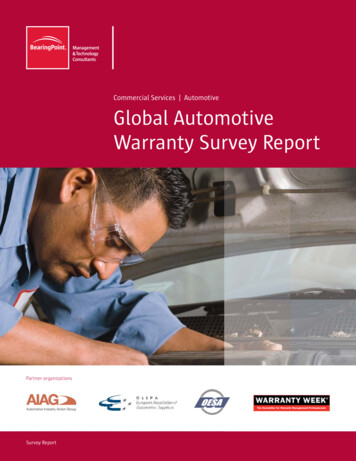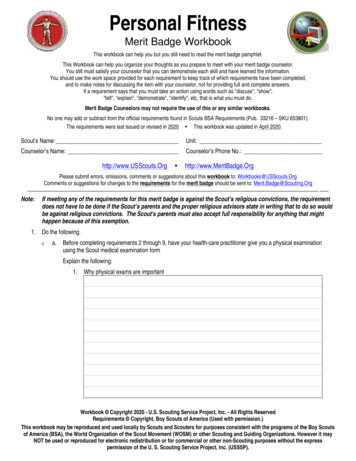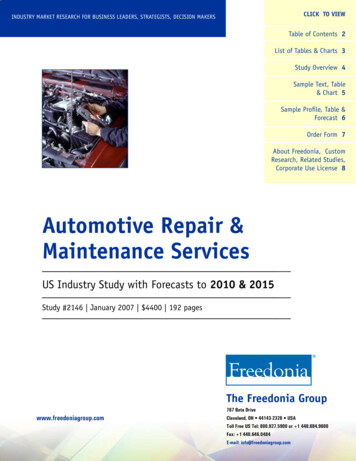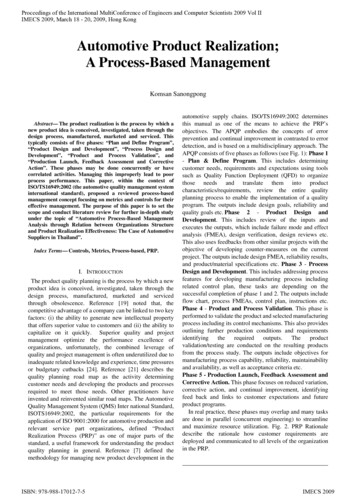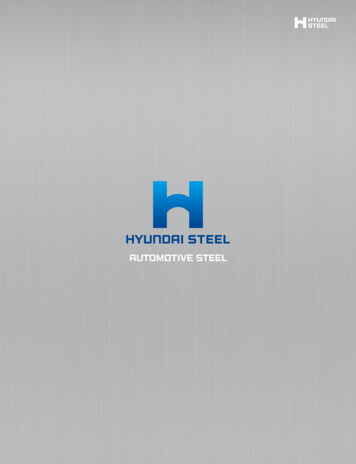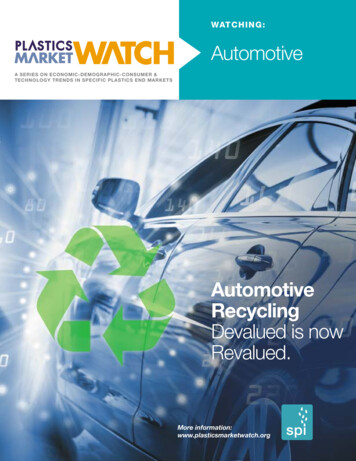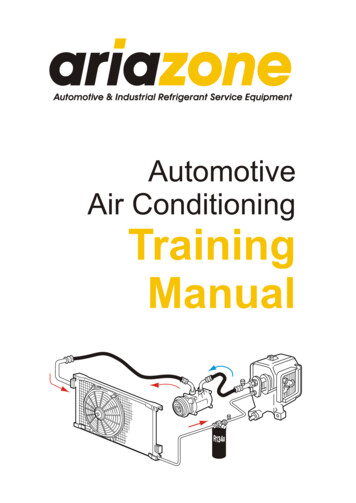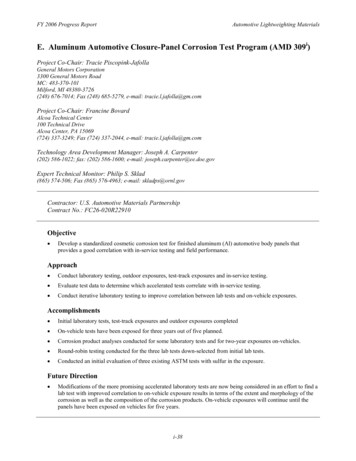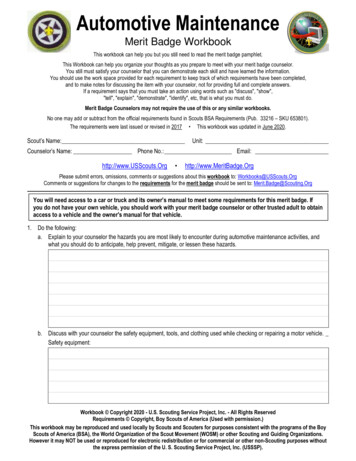
Transcription
Automotive MaintenanceMerit Badge WorkbookThis workbook can help you but you still need to read the merit badge pamphlet.This Workbook can help you organize your thoughts as you prepare to meet with your merit badge counselor.You still must satisfy your counselor that you can demonstrate each skill and have learned the information.You should use the work space provided for each requirement to keep track of which requirements have been completed,and to make notes for discussing the item with your counselor, not for providing full and complete answers.If a requirement says that you must take an action using words such as "discuss", "show","tell", "explain", "demonstrate", "identify", etc, that is what you must do.Merit Badge Counselors may not require the use of this or any similar workbooks.No one may add or subtract from the official requirements found in Scouts BSA Requirements (Pub. 33216 – SKU 653801).The requirements were last issued or revised in 2017 This workbook was updated in June 2020.Scout’s Name:Unit:Counselor’s Name: Phone No.: Email:http://www.USScouts.Org http://www.MeritBadge.OrgPlease submit errors, omissions, comments or suggestions about this workbook to: Workbooks@USScouts.OrgComments or suggestions for changes to the requirements for the merit badge should be sent to: Merit.Badge@Scouting.OrgYou will need access to a car or truck and its owner’s manual to meet some requirements for this merit badge. Ifyou do not have your own vehicle, you should work with your merit badge counselor or other trusted adult to obtainaccess to a vehicle and the owner's manual for that vehicle.1. Do the following:a. Explain to your counselor the hazards you are most likely to encounter during automotive maintenance activities, andwhat you should do to anticipate, help prevent, mitigate, or lessen these hazards.b. Discuss with your counselor the safety equipment, tools, and clothing used while checking or repairing a motor vehicle.Safety equipment:Workbook Copyright 2020 - U.S. Scouting Service Project, Inc. - All Rights ReservedRequirements Copyright, Boy Scouts of America (Used with permission.)This workbook may be reproduced and used locally by Scouts and Scouters for purposes consistent with the programs of the BoyScouts of America (BSA), the World Organization of the Scout Movement (WOSM) or other Scouting and Guiding Organizations.However it may NOT be used or reproduced for electronic redistribution or for commercial or other non-Scouting purposes withoutthe express permission of the U. S. Scouting Service Project, Inc. (USSSP).
Automotive MaintenanceScout's Name:Tools:Clothing:Use this equipment, tools, and/or clothing (when needed or called for) in meeting the requirements for this merit badge.2. General Maintenance, Safety, and Registration. Do the following: a. Review the maintenance chart in the owner's manual. Explain the requirements and time limits. b. Demonstrate how to check the following: 1. Brake fluid 2. Engine oil 3. Coolant 4. Power steering fluid 5. Windshield washer fluid 6. Transmission fluid 7. Battery fluid (if possible) and condition of the battery terminalsc. Locate the fuse boxes; determine the type and size of fuses. Demonstrate the proper replacement of burned-out fuses.d. Demonstrate how to check the condition and tension of belts and hoses.e. Check the vehicle for proper operation of its lights, including the interior overhead lights, instrument lights, warninglights, and exterior bulbs.f. Locate and check the air filter(s).Automotive Maintenance - Merit Badge WorkbookPage. 2 of 17
Automotive MaintenanceScout's Name: g. Explain the purpose, importance, and limitations of safety belts and passive restraints.Purpose:Importance:Limitations: h. Find out the requirements for your state’s emissions and safety inspections (as applicable), including how often avehicle needs to be inspected. i.Explain the importance of registering a vehicle and find out the annual registration fee for renewing your family car'sregistration.3. Dashboard. Do the following:a. Explain the function of the fuel gauge, speedometer, tachometer, oil pressure, and engine temperature gauge.Fuel gauge:Speedometer:Automotive Maintenance - Merit Badge WorkbookPage. 3 of 17
Automotive MaintenanceScout's Name:Tachometer:Oil pressure:Enginetemperaturegauge: Point out each one on the instrument cluster.b. Explain the symbols that light up on the dashboard and the difference between the yellow and red symbols.Explain each of the indicators on the dashboard, using the owner's manual, if necessary.Automotive Maintenance - Merit Badge WorkbookPage. 4 of 17
Automotive MaintenanceScout's Name:4. Tires. Do the following:a. Explain the difference between tire manufacturer's and vehicle manufacturer's specifications and show where to findthem.b. Demonstrate how to check pressure and properly inflate a tire. Check the spare tire and make sure it is ready for use.c. Explain why wheel alignment is important to the life of a tire.Explain camber, caster, and toe-in adjustments on wheel alignment.Camber:Caster:Toe-in:d. Explain the purpose of the lateral-wear bar indicator.Automotive Maintenance - Merit Badge WorkbookPage. 5 of 17
Automotive MaintenanceScout's Name:e. Explain how to dispose of old tires in accordance with local laws and regulations.5. Engine. Do the following:a. Explain how an internal combustion engine operates.Tell the differences between gasoline and diesel engines.Explain how a gasoline-electric hybrid vehicle is powered.b. Explain the purpose of engine oil.Automotive Maintenance - Merit Badge WorkbookPage. 6 of 17
Automotive MaintenanceScout's Name:Explain the API service code, the SAE number, and the viscosity rating.APIservicecode:SAEnumber:Viscosityrating:c. Explain where to find the recommended oil type and the amount of oil to be used in the vehicle's engine.6. Cooling system. Do the following:a. Explain the need for coolant in the cooling system, and the importance of selecting the correct coolant type for a givenvehicle.b. Explain how to flush and change the engine coolant in the vehicle, and how to properly dispose of the used coolant.Flush:Change:Automotive Maintenance - Merit Badge WorkbookPage. 7 of 17
Automotive MaintenanceScout's Name:Disposal:7. Fuel system. Do the following:a. Explain how the air and fuel systems work together and why it is necessary to have an air filter and fuel filter.How the air and fuel systems work togetherWhy it is necessary to have an air filter:Why it is necessary to have a fuel filter.b. Explain how a how a fuel injection system works and how an on-board computer works with the fuel injection system.Automotive Maintenance - Merit Badge WorkbookPage. 8 of 17
Automotive MaintenanceScout's Name:8. Ignition and electrical systems. Do the following:a. Diagram and explain the parts of the electrical system.b. Explain the engine’s firing order.Automotive Maintenance - Merit Badge WorkbookPage. 9 of 17
Automotive MaintenanceScout's Name:c. Explain the purpose of the spark gap.d. Demonstrate how to safely connect jumper cables to your car battery.9. Drive Train. Do the following:a. Diagram the drive train and explain the different parts.Automotive Maintenance - Merit Badge WorkbookPage. 10 of 17
Automotive MaintenanceScout's Name:b. Explain the difference between automatic and standard transmissions.Automatic:Standard:c. Explain the types of automatic transmission fluid.d. Explain the types of lubricants used in a standard transmission and in the differential and transfer case.Transmission:Differential:e. Explain the difference between front-wheel, rear-wheel, and four-wheel drive.Front-wheel drive:Rear-wheel drive:Automotive Maintenance - Merit Badge WorkbookPage. 11 of 17
Automotive MaintenanceScout's Name:Four-wheel drive:10. Brake System. Do the following:a. Explain the brake system (including anti-lock systems) and how it operates.b. Explain the differences between disc and drum systems.Disc:Drum:c. Demonstrate how to check the condition of a vehicle's brake system.After checking, make recommendations for repairs (if necessary).Automotive Maintenance - Merit Badge WorkbookPage. 12 of 17
Automotive MaintenanceScout's Name:11. Do TWO of the following: a. Determine the value of three different vehicles you are interested in purchasing. One must be new and one must beused; the third vehicle can be new or used. For each vehicle, find out the requirements and cost of automobileinsurance to include basic liability and options for collision, comprehensive, towing, and rental car. Using the threevehicles you chose and with your merit badge counselor's assistance, complete the operation/maintenance chartprovided in the merit badge pamphlet. Use this information to determine the operating cost per mile for eachvehicle, and discuss what you learn with your counselor.New vehicle:Value:Cost of automobile insurance:Operating cost per mile:Used vehicle:Value:Cost of automobile insurance:Operating cost per mile:Third vehicle:Value:Cost of automobile insurance:Operating cost per mile:What you learned: b. Choose a car cleaner and wax product for a vehicle you want to clean.Cleaner:Wax:Explain clear-coat paint and the precautions necessary for care.Automotive Maintenance - Merit Badge WorkbookPage. 13 of 17
Automotive MaintenanceScout's Name: Clean the vehicle, both inside and out, and wax the exterior. Use a vinyl and rubber protectant (on vinyl tops, rubber door seals, sidewalls, etc.) and explain the importance ofthe protectant. c. Locate the manufacturer's jack .Use the jack to demonstrate how to engage the jack correctly on the vehicle, thenchange a tire correctly. d. Perform an oil filter and oil change on a vehicle.Explain how to properly dispose of the used oil and filter.12. Find out about three career opportunities in the automotive industry.1.2.3.Pick one and find out about the education, training, and experience required for this profession.Career:Education:Automotive Maintenance - Merit Badge WorkbookPage. 14 of 17
Automotive MaintenanceScout's Name:Training:Experience:Discuss this with your counselor, and explain why this profession might interest you.When working on merit badges, Scouts and Scouters should be aware of some vital information in the current edition ofthe Guide to Advancement (BSA publication 33088).Important excerpts from that publication can be downloaded meritbadges.pdf.You can download a complete copy of the Guide to Advancement from tomotive Maintenance - Merit Badge WorkbookPage 15 of 16
Automotive MaintenanceScout's Name:Operation Maintenance ChartThe Auto Maintenance Merit Badge Pamphlet is missing the required Operation Maintenance Chart! Here is a sample chart thatyou might consider using until the BSA chart is published. The following is based on the interactive true cost of ownershipcalculator at Edmunds.com: New VehicleMonthly costsCalculations for: Year: Make/Model:Total Purchase Price Including taxes, dealer fees, etc.Financing (Payment) Assuming 3% of Price: Price X 0.03 (financing rates and terms vary greatly)Depreciation Assuming 1% of Price: Price X 0.01 (new vehicles depreciate more)Insurance A young male might average 150 for a new car with comprehensive &collisionTax & Fees Annual license and registration, fees, etc. 12 (typically near 10/month)Gas /gallon Miles/gallon X Miles/month (1,000 miles/month isaverage)Maintenance/Repairs Batteries, brakes, hoses, exhaust system, tires, engine, etc ( 100/month?)Total Financing Depreciation Insurance Taxes Gas Maintenance Monthly Miles miles Use same assumption as for gas. 1,000 miles/month is average. Cost per mile The IRS assumes 56 cents/mile in 2013.Used VehicleTotal Purchase PriceFinancing (Payment)DepreciationInsurance Tax & FeesGas Maintenance/RepairsTotal Monthly Miles Cost per mile Third VehicleTotal Purchase PriceFinancing (Payment)DepreciationInsurance Tax & FeesGasMaintenance/RepairsTotal Monthly Miles Cost per mile Monthly costsCalculations for: Year: Make/Model:Including taxes, dealer fees, etc.Assuming 3% of Price: Price X 0.03 (financing rates and terms vary greatly)Assuming 1% of Price: Price X 0.01 (new vehicles depreciate more)A young male might average 150 for a new car with comprehensive &collisionAnnual license and registration, fees, etc. 12 (typically near 10/month) /gallon Miles/gallon X Miles/month (1,000 miles/month isaverage)Batteries, brakes, hoses, exhaust system, tires, engine, etc ( 100/month?) Financing Depreciation Insurance Taxes Gas Maintenancemiles Use same assumption as for gas. 1,000 miles/month is average.The IRS assumes 56 cents/mile in 2013.Monthly costsCalculations for: Year: Make/Model:Including taxes, dealer fees, etc.Assuming 3% of Price: Price X 0.03 (financing rates and terms vary greatly)Assuming 1% of Price: Price X 0.01 (new vehicles depreciate more)A young male might average 150 for a new car with comprehensive &collisionAnnual license and registration, fees, etc. 12 (typically near 10/month) /gallon Miles/gallon X Miles/month (1,000 miles/month is avg.)Batteries, brakes, hoses, exhaust system, tires, engine, etc ( 100/month?) Financing Depreciation Insurance Taxes Gas Maintenancemiles Use same assumption as for gas. 1,000 miles/month is average.The IRS assumes 56 cents/mile in 2013.Automotive Maintenance - Merit Badge WorkbookPage. 16 of 17
Automotive Maintenance - Merit Badge Workbook Page. 14 of 17 Clean the vehicle, both inside and out, and wax the exterior. Use a vinyl and rubber protectant (on vinyl tops, rubber d

